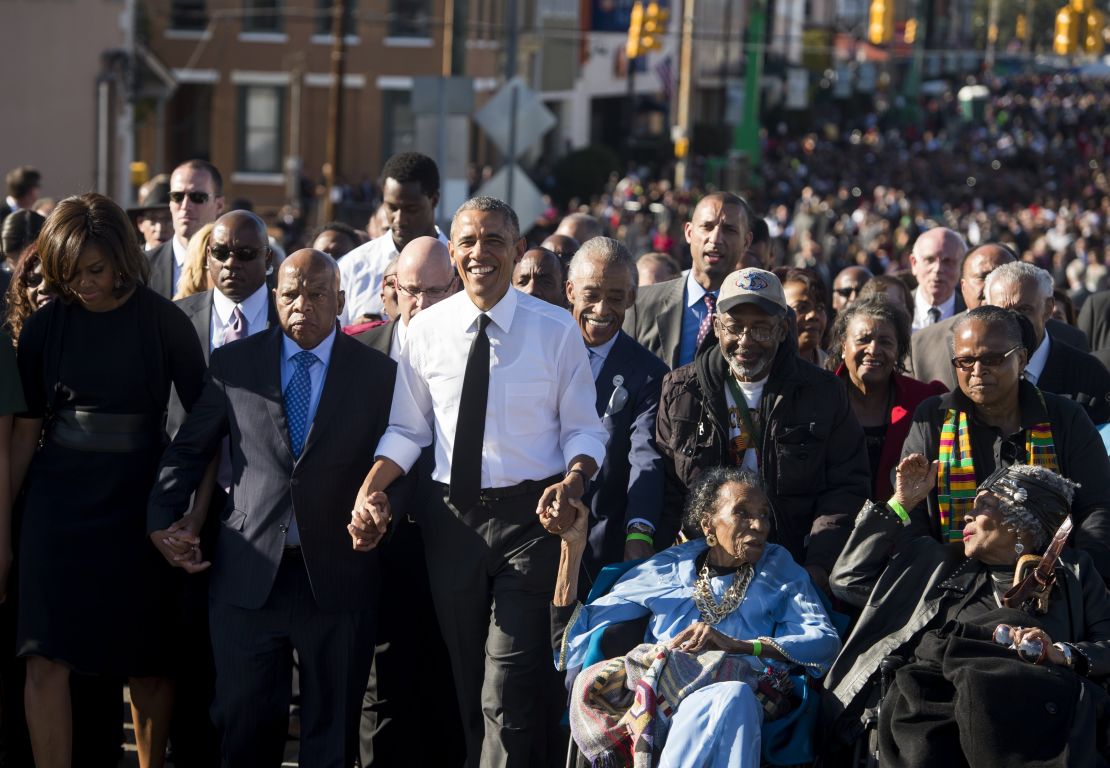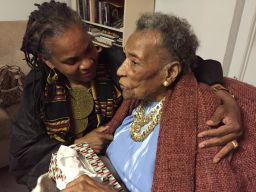Story highlights
Longtime civil rights activist Amelia Boynton Robinson played a pivotal role in Selma, Alabama
A photo of her lying beaten unconscious by white troopers shocked the nation
President Barack Obama held her hand as they crossed the Edmund Pettus Bridge 50 years later
Amelia Boynton Robinson, a matriarch of the civil rights movement immortalized in a photograph taken on Bloody Sunday, has died.
She turned 104 on August 18, though some in her closest circles insist she was 110.
Boynton Robinson suffered a stroke last month and had been hospitalized in Montgomery, Alabama. She died early Wednesday, relatives said.
Her remarkable life was reintroduced to America this year with the movie “Selma,” which portrayed the 1965 demonstrations that led to the passage of the 1965 Voting Rights Act.
Boynton Robinson grew up in Savannah, Georgia, and worked as an educator. She moved to Alabama in the 1930s with her husband, Samuel Boynton. The couple began fighting for voting rights in the poorest parts of the state entrenched in the thick of Jim Crow.

By the time the civil rights movement gained steam in the 1960s, the Boyntons were leading the efforts in Selma. They let the Student Nonviolent Coordinating Committee use their insurance office as headquarters and opened up their home for planning sessions and as shelter for fellow civil rights activists. She played a pivotal role in persuading the Rev. Martin Luther King Jr. to focus on Selma.
Boynton Robinson was among the 600 or so people who attempted to cross the Edmund Pettus Bridge in March 1965 in a protest march from Selma to Montgomery, the state capital. She’d felt anxious that day but felt strengthened by women who had sacrificed so much already, she told me when I met her last December.
A wall of white state troopers met the marchers at the bottom of the bridge and unleashed their fury. They fired tear gas and clubbed people in what became known as Bloody Sunday.
Boynton Robinson was beaten unconscious. She described the moment many years later in her book, “Crossing Jordan.”

“As I stepped aside from the trooper’s club, I felt a blow on my arm that could have injured me permanently had it been on my head. Another blow by a trooper as I was gasping for breath knocked me to the ground and there I lay unconscious. Others told me that my attacker had called to another that he had the “damn leader.” One of them shot tear gas all over me. The plastic rain cap that Margaret Moore gave me may have saved my life; it had slipped down over my face and protected my nose somewhat from the worst of the fumes.”
A newspaper photo of her lying on the ground, a middle-aged housewife left for dead, shocked the entire nation. That is how most Americans came to know of her.
I had the good fortune to meet her last December when I was invited to watch “Selma” with her at her home. That was just three months before the 50th anniversary of Bloody Sunday and she told me she was holding on to see that day.
A few weeks later Boynton Robinson attended the State of the Union speech as a special guest of Terri Sewell, the first black woman to represent Alabama in Congress. Sewell said she felt indebted to Boynton Robinson, who had cleared the path for her.
In March, President Barack Obama, the nation’s first black president, walked over the Edmund Pettus with Boynton Robinson. She was frail and in a wheelchair. The president held her hand as they crossed the Alabama River, a photo of which currently makes up his Twitter page.
Those who know her say she was a gift in their lives; that she inspired younger generations to carry on the fight.
What many didn’t know is that by then, she had already run as a Democratic congressional candidate in Alabama, making her the first African-American and the first woman ever to do so.
Amazingly, she won 11% of the vote long before federal protection was afforded for black people at Southern polls.
She was courage personified, said Yomi Goodall, a friend and relative. She was inspiration and strength.
She lived the last decades of her life in Tuskegee, guided, she told me, by her Christian faith. She died harboring no animosity for anyone, not even those who might have hated her for the color of her skin.
Funeral arrangements have not been announced but the family is planning a ceremony at the Edmund Pettus Bridge.


